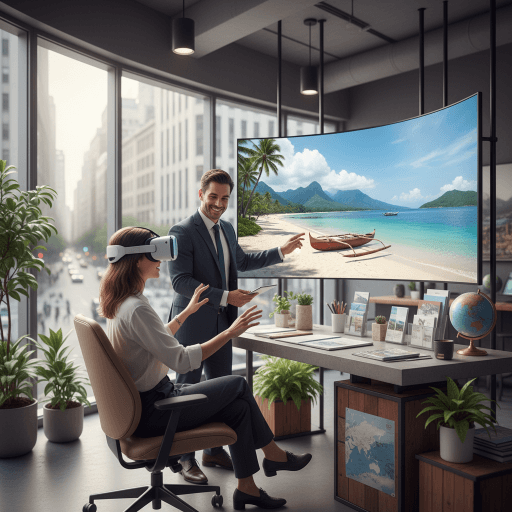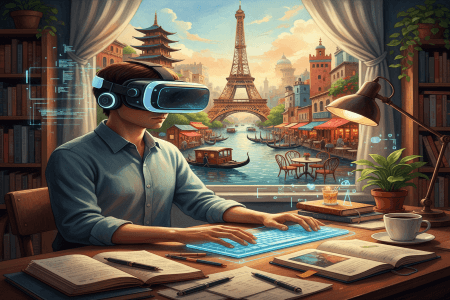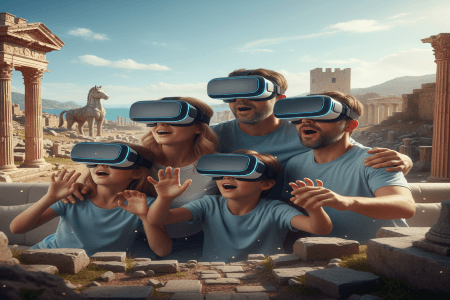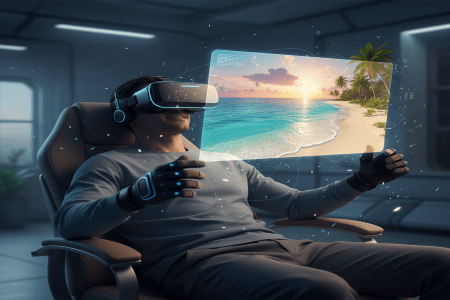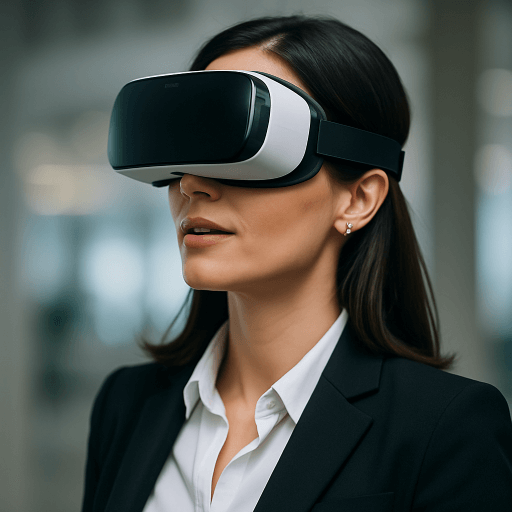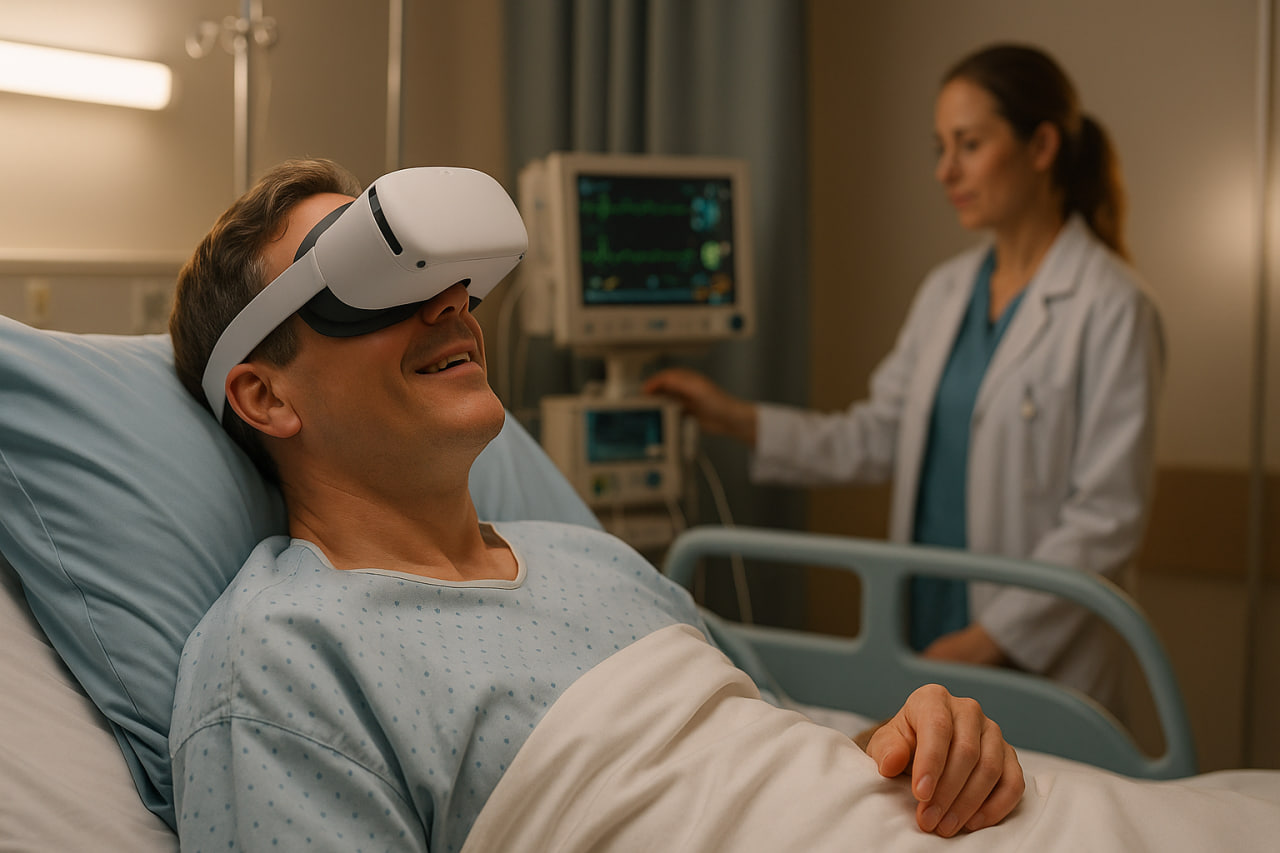Ever booked a trip only to get there and regret it? What if you could try it out before actually going?
Travel isn’t like buying clothes or shoes, where you can try before you buy. Booking a trip used to be risky. You’d go to a travel agency, ask about prices, hotels, and the destination, but if you’d never been there, it was a gamble—like cutting open a watermelon without knowing if it’s sweet. Many people spent a lot and came back regretting it.
Now VR changes that. You can “try it before you buy it.” Walk around the place without leaving home. Gartner predicts that by 2025, half of all travel agencies will use VR to showcase destinations. Interest in VR travel experiences rose 40% just last year.
Let’s see how it’s changing the way we travel.
Why VR should lead to real adventures!
When I was researching for this article, I came across some claims saying people no longer need to leave their homes to visit new places. Honestly, I don’t buy that. I’d rather start this piece by sharing what I really think and feel.
To me, social media is like a wonderland; you get to find like-minded people you’d probably never have met otherwise. But still, wouldn’t it be amazing if all those online chats and talks sometimes turned into real, in-person meetings? And sometimes, they actually do.
I remember once Austin Kleon, a well-respected author, met with his readers and asked them what’s so great about the internet and social media. Everyone pointed to the table they were gathered around and said, “This!” They meant that the internet made that real-life gathering possible.
I firmly believe nothing can replace face-to-face conversations, friendships, or the magic that happens in person. In this article, I want to make it clear that VR in tourism and exploring the world should lead us toward more real experiences, not replace them. I’ll also dig into what exactly VR is used for in this field and how it’s changing the way we travel.
Exploring the world without leaving the home
Well, the claim is true. VR really does feel close to real life experiences, and its immersion makes that possible. When you put on the headset and walk along the beach, it honestly feels like you’re there: you hear the waves, you feel the atmosphere. But the point isn’t to stop there. The whole purpose should be to push you to actually step out of your home and go experience it for real.
Why? Because let’s be honest—human beings don’t want to do anything, even things that are wonderful, even the things we love the most.
Take my own family as an example. For years we’ve been planning to visit this beautiful natural spot nearby. We always talk about it, wish for it, plan for it… but it never actually happens. Just last week my mom and husband were planning it again, and I didn’t even pay attention, because I knew it would end up like the other plans.
What could actually push us to make the trip is if we had a VR headset. Imagine walking along that river virtually, seeing the nature, feeling the atmosphere. That immersive experience could finally break the resistance. But when you’ve never seen the place, when it’s just some vague description, you simply don’t have enough willpower or motivation to pack your bags and go.
Another example is my dad. He once bought a tent and said, “From now on, we’re going to travel a lot.” For us, that was huge, because he didn’t really like long trips; he always preferred going back to the same spots again and again. But the truth is, nothing changed. Those trips never happened. And then, he got sick and passed away from cancer.
Honestly, I think what he needed was a VR headset. If he could’ve “traveled” with it first, walked through new places, seen what they looked like, felt how amazing they were, I believe he would’ve broken that pattern. He would’ve realized that going somewhere new isn’t awful or scary, but actually exciting.
Travel agencies
Speaking of conviction, did you know travel agencies are using VR to get more people to book trips? It’s normal for someone to walk in, ask about the price, check how long the trip is, and then think, “Five days for this much? Nah, I’d rather stay home and enjoy myself.”
The key is making customers believe the trip is really worth it, that they’ll have an amazing experience and get their money’s worth. But how can they know if they’ve never actually seen the place? That’s where VR comes in.
Once people get a taste of the experience, they’re way more likely to book it. That’s why travel agencies now host VR events, so people can explore the place first and get convinced before spending a dime.
In fact, this technology is starting to replace traditional websites and brochures, and that shows the future of virtual reality.
Over tourism
I already told you one great thing about the internet: it can bring people together in real life after connecting online. But now, let’s talk about the awful side. Unfortunately, horrible or not-so-wise people—by “wise” I don’t mean degrees or titles; you can have ten degrees and still not be a wise person—have a platform to spread nonsense. And people believe it too easily.
While researching this topic, I saw some blogs suggesting the “solution” to overtourism is to explore the world virtually and just stay home. Really? That’s not how I see it. The solution isn’t sitting at home “saving the world.” That’s ridiculous. Our generation doesn’t need to stay home more—we need to get out more. Centuries ago, the philosopher Seneca advised us to take more outdoor walks because it helps nourish the mind. So, we need more nature and new places, not less.
So what’s the solution? Let me tell you a story. My family loves nature and gardens to an extreme degree; every weekend, we can’t stay home, we’ve got to go camping. This year, though, we mostly stayed in our own garden and didn’t visit anywhere new. Then, a few weeks ago, we went to a place a little further away. The weather was hot, the whole place felt off, and I was like, “I can’t sit here. Let’s go somewhere else.” Hours wasted, frustration built up.
How many times have you traveled somewhere only to realize you hate it? Time and money wasted. VR can help reduce overtourism by letting people “try before they go.” Show them the place virtually first and let them decide if it’s worth visiting. Many times, my husband would take me somewhere saying, “It’s amazing!” but it wasn’t that exciting to me.
Another way VR helps: it convinces people who might not truly enjoy a vacation to think twice. Some people think they’ll be happy just by being somewhere new, but if you’re unhappy inside, you’ll drag that unhappiness everywhere. VR lets you see exactly what you’d experience before going, so you can decide if it’s worth your time.
What Can Virtual Reality NOT Replace?
VR should be used to get people excited to travel, not to replace traveling. Sure, VR can give you a taste of the sights, sounds, and vibes of a place; but you can’t actually eat the food, smell the flowers, or feel the ocean breeze. Plus, wearing a headset for hours is uncomfortable, and motion sickness is real. So it’s super important to be honest about what VR can do in tourism and not promise things it simply can’t deliver.
VR for Writers Who Can’t Travel
I might sound a bit contradictory here, but VR can actually be really useful for people who don’t want to travel much but need to “be” somewhere, like novel writers. There’s a bestselling author who, in his masterclass, explained how he starts writing a novel: first, he researches everything about the topic, all the facts he needs. But then he says it’s crucial to actually be in the place he’s writing about. Seeing it in real life makes a huge difference.
I’ve faced this problem myself. For years, I’ve imagined my story in my head, but there’s always one big obstacle: the setting. My characters aren’t from my city; they live somewhere else, and I’ve never been there. So describing the streets, the cafés, the little details? Really hard. But with a VR headset, I could “go” to that place virtually, walk around, see the surroundings, and finally write my scenes accurately, even without actually traveling there.
Why VR makes visiting historical places fun
Take, for example, the historical site of Troy in modern-day Turkey. Why should I even care about this place? Why should I be excited to visit it? Honestly, even though I usually find these old sites boring, Troy is one I’d like to see one day. Why? Because of the story behind it. If I didn’t know the story, I wouldn’t care at all.
Richard Powers writes in The Overstory: “The best arguments in the world won’t change a single person’s mind. The only thing that can do it is a good story.” That’s the thing, just pointing at buildings and saying “this is significant” isn’t enough. You have to stir emotions. But how? With stories.
So what makes Troy unique? The Trojan Horse. The Greeks built that big horse from wood and gave it to the Trojans as a gift. The Trojans thought the Greeks gave up trying to take the city, but really, soldiers were hiding inside it. Once the horse was brought in, the soldiers snuck out at night, and everything changed.
Now imagine using VR to experience this. VR is so close to real life: it’s immersive, interactive. Put on a headset, see the battle unfold, maybe even grab a weapon and watch the action up close. Doesn’t that make you want to know more? Doesn’t it make you excited to actually visit the site?
And if you’re still not convinced, check out Ryan Holiday, the American bestselling author. He writes about Stoicism and recently visited Greece. He went exactly to the places he writes about, and the experience was totally unique for him. He even ran a marathon there.
A custom VR development service is the key to creating an unforgettable experience.
Thanks for reading! Whether you’re a travel agency looking to bring in more customers, a creative writer or artist searching for inspiration, or just a tourist who’s ever felt bored at historical sites and wants a VR travel experience to get ready for your next adventure, send me a WhatsApp message and let’s chat about the details.
Can VR really make people want to travel more, or does it just keep them at home?
It’s most likely going to trigger people’s enthusiasm to travel even more. People need to spend more time outside their homes, and VR can help them do that.
Can VR help people avoid wasting time and money on trips they won’t enjoy?
Yes, exactly! That’s the whole point of VR in tourism. It helps customers pick the right spot that matches their taste and preferences, instead of choosing blindly and regretting it later.
Who benefits the most from VR travel experiences, novel writers, casual tourists, or travel agencies?
Everyone’s a winner here. Tourists, for sure. Writers too, especially those who need to experience a setting to describe it properly. And of course, travel agencies; because once people get a taste of a place through VR, they can’t stop thinking about booking the real thing.
Can VR make visiting historical sites actually fun instead of boring?
Definitely. VR lets people “travel through time” and witness the events, battles, and stories that took place there. So when they actually visit, it’s not just a pile of old bricks, they already know the story behind it. That makes the whole experience way more exciting.
